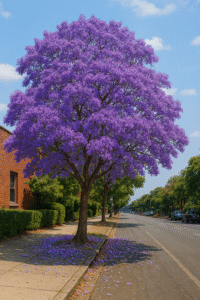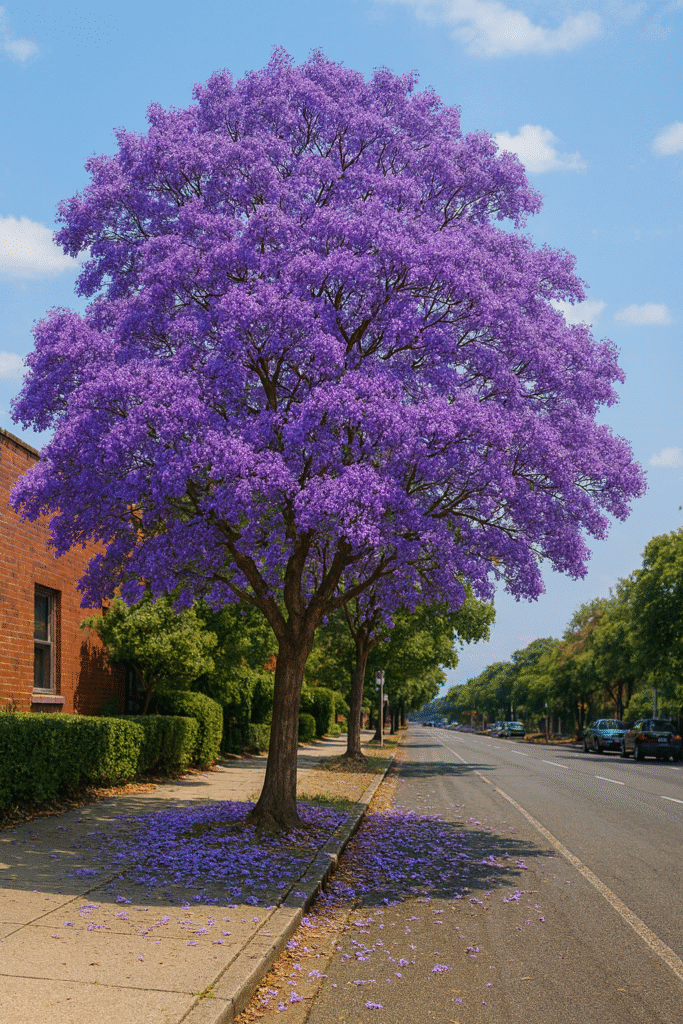The jacaranda is one of the most beautiful and iconic trees found in various parts of the world, widely admired for its purple blossoms that turn streets and gardens into breathtaking natural displays. Despite its popularity, many people don’t know the deeper story behind it. In this article, you’ll discover 5 fascinating facts about the jacaranda, while also learning more about its history, uses, and cultural importance.
1. Origin and distribution of the jacaranda
The jacaranda belongs to the Jacaranda genus, which includes more than 50 different species. Native to tropical and subtropical regions of Latin America — especially Brazil, Argentina, Bolivia, and Paraguay — the most famous species is Jacaranda mimosifolia, commonly cultivated as an ornamental tree because of its spectacular blooming.
Over time, the jacaranda was introduced to other continents. Today, it can be found in South Africa, Australia, the United States (particularly California and Florida), and Spain, where its purple flowers paint entire avenues during spring. This expansion has made the jacaranda a global symbol of natural beauty.
2. The purple blossoms that enchant the world
One of the main attractions of the jacaranda is its vibrant flowers in shades of lilac and blueish-purple. Blooming usually occurs between September and November in the Southern Hemisphere, coinciding with spring, though the timing may vary by region. During this period, the tree sheds part of its foliage, creating a striking contrast with clusters of blossoms that look like violet clouds suspended on its branches.
In several cities, the flowering season has become a cultural and touristic event. In Pretoria, South Africa, the tree is so abundant that the city is known as the “Jacaranda City”, where thousands of specimens transform the streets into natural tunnels of color. The same happens in Sydney, Australia, and Buenos Aires, Argentina, where the jacaranda plays an important role in urban landscapes.
3. Jacaranda as a cultural and emotional symbol
The jacaranda is not just a beautiful tree; it has also become a cultural symbol in many parts of the world. In several traditions, its blooming season is associated with hope, renewal, and prosperity. In Brazil, it is often planted in squares and avenues, becoming a familiar sight in urban design.
In South Africa, there is even a curious belief: students say that if a jacaranda blossom falls on your head during exam season, it is a sign of good luck. In other cultures, the tree represents wisdom, spirituality, and the passage of time, as its intense but short-lived beauty reminds us of the importance of cherishing every moment.
4. Jacaranda wood: strong and valuable
Beyond its ornamental appeal, the jacaranda is also known for its high-quality wood. In fact, the word “jacaranda” can refer to different species that provide valuable timber, some of which are highly prized in fine woodworking and musical instrument manufacturing.
Jacaranda wood is dense, durable, and typically dark with striking grain patterns, making it ideal for luxury furniture, guitars, pianos, and decorative items. However, due to overexploitation, some jacaranda species — such as the Brazilian Dalbergia nigra, known as Brazilian rosewood or jacaranda-da-bahia — are now endangered, and their trade is internationally restricted.
This duality — as both a beloved ornamental tree and a source of noble wood — highlights the jacaranda’s ecological and economic significance.
5. The ecological role of the jacaranda
The jacaranda also plays an important ecological role. Its blossoms attract bees, butterflies, and other pollinators, helping sustain biodiversity. In urban environments, jacaranda trees contribute to improving air quality, providing shade, and reducing heat in city areas.
Thanks to its relatively fast growth, the jacaranda is also a good option for reforestation and urban greening projects. However, since it has been introduced outside of its native range, it is important to manage its cultivation carefully to avoid it becoming invasive and displacing local vegetation.
Extra curiosities about jacaranda
-
In some cities, entire streets are lined exclusively with jacaranda trees, creating stunning flower corridors that attract tourists and photographers.
-
The flowering period has inspired poems, songs, and paintings throughout history.
-
In English, the word jacaranda is used the same way as in Portuguese (without the accent) and has become widely recognized.
Conclusion
The jacaranda is much more than a tree with purple flowers. It carries history, culture, ecological value, and economic importance. Whether in a private garden, a busy avenue, or a public square, the jacaranda always stands out and captivates the eye.
Learning about its uses, symbolism, and role in biodiversity helps us appreciate this remarkable tree even more. At the same time, it reminds us of the importance of preserving native species and practicing sustainable planting.
Whether for its welcoming shade, dazzling blossoms, or noble wood, the jacaranda is a true natural and cultural treasure that deserves recognition and celebration.

🚽 Comfort and Convenience Anywhere!
Meet the Portable Toilet, Upgraded 15” Camping Toilet – the perfect solution for camping, hiking, road trips and even for truck drivers.
Compact, foldable, with a secure lid and removable paper holder, this portable potty ensures hygiene and practicality for all your adventures.

🌿 Discover the Secrets of Jurubeba!
Learn more about the amazing Jurubeba, a Brazilian plant with remarkable health benefits and cultural importance.
Explore its uses, curiosities, and 5 fascinating facts that make this plant so unique.

